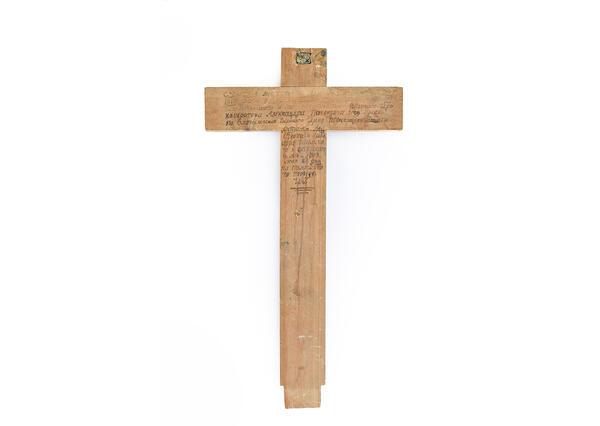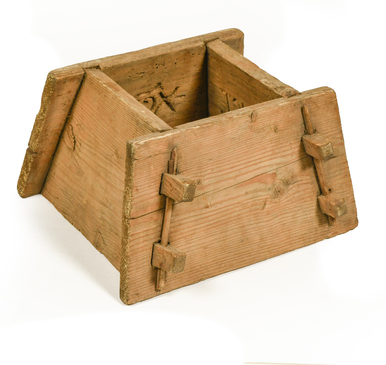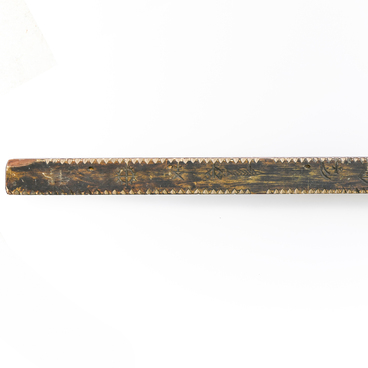The exhibition of the Archbishop’s House includes a four-pointed reliquary cross. It is very simple and has no decorative details. The cross consists of two smooth wooden planks that fit tightly. The vertical piece is elongated, and in its upper part, there is a small rectangular recess with a metal inlay around the perimeter. Over time, the inlay has changed the color to a darker shade. Its edges are flat and do not protrude over the wooden surface. The indent is filled with a mixture of wax and incense.
The lower end of the vertical plank of the reliquary cross is narrower. The edges of the cross are smooth. The crossbar on the front side has an inscription in dark ink, but it is poorly preserved. Therefore, the text can be read only in fragments, and it has been impossible to restore its full meaning.
The tradition to wear crosses or medallions with pieces of Christian relics on the chest dates back to antiquity. Not only the relics of saints, but also small fragments of prosphora — church bread used in the sacrament of communion — were placed in such pendants. People believed that heavenly powers protected the owner of such an object. Therefore, reliquary crosses were often given to warriors, travelers, all those who spent a lot of time away from home.
Reliquary pectoral and altar crosses were made of copper, bronze, silver, less often of gold. Usually, they were decorated with cast or carved patterns, inlays of precious stones, and enamel. But there were also versions without decorations: they were often used by monks, pilgrims, or hermits. In this way, they emphasized that they were not interested in earthly possessions and cared only for the spiritual. Simple wooden reliquary crosses were also worn by poor peasants who had no money for expensive items.
There were always small recesses in such crosses, where particles of the relics were put. They were covered with a mixture of wax and incense. Those materials were believed to drive way evil spirits from the owner.
Reliquary crosses were made not only in the form of crosses and medallions. There were also containers of various shapes and sizes, and sometimes the relics were placed inside icons.
The lower end of the vertical plank of the reliquary cross is narrower. The edges of the cross are smooth. The crossbar on the front side has an inscription in dark ink, but it is poorly preserved. Therefore, the text can be read only in fragments, and it has been impossible to restore its full meaning.
The tradition to wear crosses or medallions with pieces of Christian relics on the chest dates back to antiquity. Not only the relics of saints, but also small fragments of prosphora — church bread used in the sacrament of communion — were placed in such pendants. People believed that heavenly powers protected the owner of such an object. Therefore, reliquary crosses were often given to warriors, travelers, all those who spent a lot of time away from home.
Reliquary pectoral and altar crosses were made of copper, bronze, silver, less often of gold. Usually, they were decorated with cast or carved patterns, inlays of precious stones, and enamel. But there were also versions without decorations: they were often used by monks, pilgrims, or hermits. In this way, they emphasized that they were not interested in earthly possessions and cared only for the spiritual. Simple wooden reliquary crosses were also worn by poor peasants who had no money for expensive items.
There were always small recesses in such crosses, where particles of the relics were put. They were covered with a mixture of wax and incense. Those materials were believed to drive way evil spirits from the owner.
Reliquary crosses were made not only in the form of crosses and medallions. There were also containers of various shapes and sizes, and sometimes the relics were placed inside icons.



